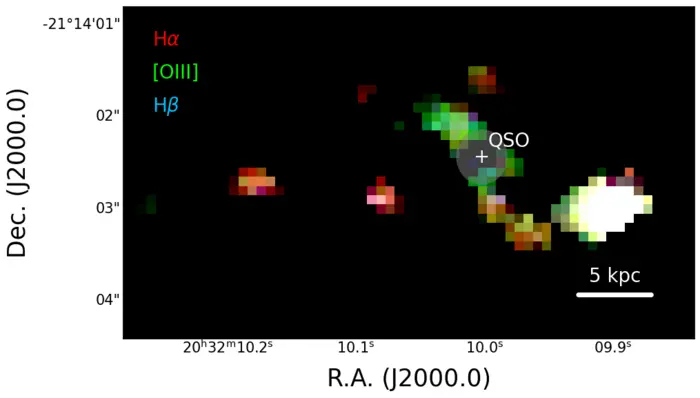The James Webb Space Telescope has captured an extraordinary cosmic event in the early universe. A quasar, powered by a supermassive black hole, is merging with two massive satellite galaxies. This discovery sheds new light on galaxy formation and the growth of black holes in the universe’s infancy.
An international team led by the Italian National Institute for Astrophysics (INAF) used Webb’s NIRSpec instrument to observe the quasar PJ308-21. The data they collected is of exceptional quality, with less than 1% uncertainty per pixel in the quasar’s spectrum.
A Tale of Three Galaxies
The researchers found striking differences between the quasar’s host galaxy and its two companions. The host galaxy shows high metallicity and signs of an active galactic nucleus. One satellite galaxy has low metallicity and is forming stars. The other satellite has higher metallicity and is partly influenced by the quasar’s intense radiation.
This cosmic merger is happening when the universe was less than a billion years old. Despite its young age, the system is already highly evolved. The central black hole weighs about 2 billion times the mass of our Sun.
Roberto Decarli, lead author of the study, explains: “Our study reveals that both the black holes at the centre of high-redshift quasars and the galaxies that host them undergo extremely efficient and tumultuous growth already in the first billion years of cosmic history, aided by the rich galactic environment in which these sources form”.
Webb’s Revolutionary Capabilities
The Webb Telescope’s NIRSpec instrument allowed the team to study the system in unprecedented detail. They used a technique called integral field spectroscopy, which provides a spectrum for each pixel in the image.
Federica Loiacono, an astrophysicist at INAF, highlights the importance of this capability: “Thanks to NIRSpec, for the first time we can study in the PJ308-21 system the optical band, rich in precious diagnostic data on properties of the gas near the black hole in the galaxy hosting the quasar and in the surrounding galaxies.”
This level of detail was previously impossible to achieve for such distant objects. Loiacono adds, “Only the excellent ‘view’ offered by JWST, with its unparalleled capabilities, can ensure these observations”.
The study demonstrates Webb’s transformative impact on astrophysics. Decarli concludes, “Until a couple of years ago, data on the enrichment of metals (essential for understanding the chemical evolution of galaxies) were almost beyond our reach, especially at these distances. Now we can map them in detail with just a few hours of observation, even in galaxies observed when the universe was in its infancy”.
These findings, soon to be published in Astronomy & Astrophysics, offer a glimpse into the turbulent early days of galaxy and black hole formation. They promise to reshape our understanding of how the universe evolved into what we see today.


